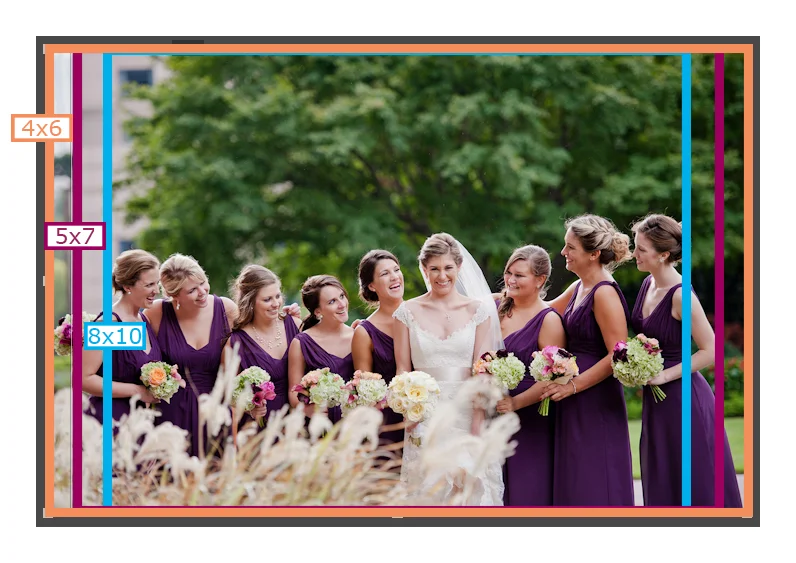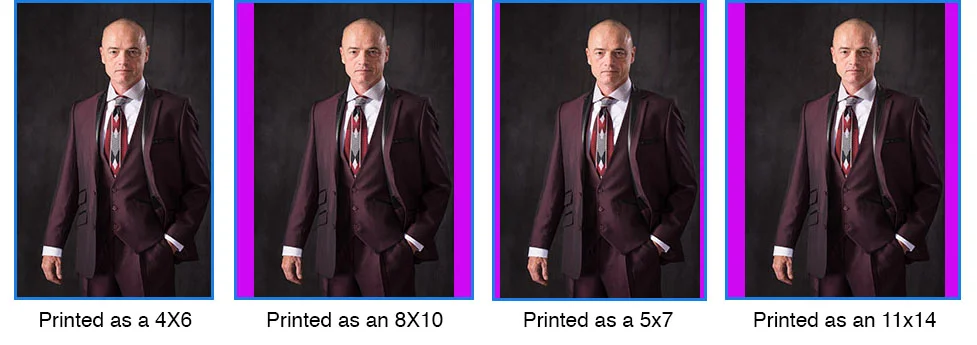UNDERSTANDING 2x3 ASPECT RATIO IMAGES
Modern professional digital cameras capture images in ratio of 2 x 3, meaning the images is 2 units tall for every 3 units wide. This is a digital carryover of the popular 35mm film size developed for the revolutionary Leica camera in the 1920’s. In the decades that followed, the 2 x 3 ratio 35mm image size became ubiquitous and was adopted by Canon, Nikon, Sony, Kodak, Fuji, Olympus, Pentax, Yachica, Fuji, Carl Zeiss, and many others. The most common print size from this ratio is 4 x 6 inches, widely view as the “standard” print size from retail print kiosks at Walmart, Costco, Target, Walgreens, etc.
As this is the aspect ratio your photographer sees all day in the camera viewfinder, your Love & Lens images were composed to look great in the 2 x 3 ratio with no addition cropping. However, due to the popularity of four different print sizes — each with a different aspect ratio — it is unlikely that every wedding image will be equally desirable when printed in each of the four different sizes.
ENLARGEMENT SIZES THAT MAINTAIN THE 2x3 ASPECT RATIO
2 x 3
4 x 6
6 x 9
8 x 12
12 x 18
16 x 24
20 x 30
24 x 36
Frames that fit these image sizes are available via online sellers such as Amazon, and a few local retailers (Target, Michaels).
CROPPING FOR POPULAR LEGACY FRAME SIZES
Of course, you can print an image composed as a 2 x 3 with a different enlargement ratio, but some image information will have to be eliminated, or cropped.
5 x 7 — This is very close to the native 2 x 3 ratio of your photographer’s camera and images printed as 5 x 7’s will have a very small amount of information cropped. Vertical compositions get a little thinner, and horizonal compositions will lose a little sky on the top and a little grass on the bottom.
8 x 10 — Made popular by large press cameras of the 1930’s ~ 1950’s and the print size is closer to a square shape. Non-vital subject information must be cropped for your image to fit the frame size. Images of large family groups are often incompatible with this print size due to people on the edges of the frame. If an 8 x 10 crop doesn’t work, print a 8 x 12 and place in an 8 x 12 frame from Amazon, Target, Michaels, etc. The same retailers that offer 8 x 12’s will often sell a larger 12 x 16 frame with a 2” white matte — which makes an excellent display space for an 8 x 12 image.
Square — 1:1 aspect photographs were all the rage in the 1960’s with the popularity of the Rolleiflex twin-lens professional cameras, and through the 1990’s by the Hasselblad single lens square cameras. Many 2 x 3 images look great when cropped square — particularly a single object (or person) in a large scene.



